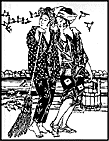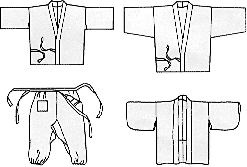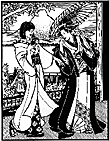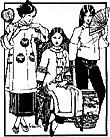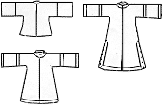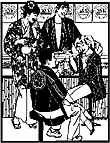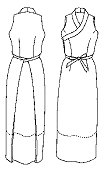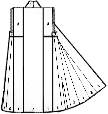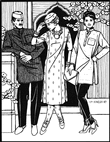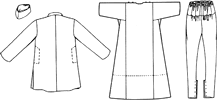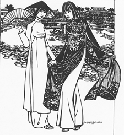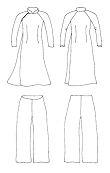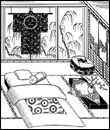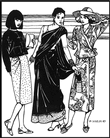|
#111
Nepali Blouse
In Nepal, this wrap-and-tie blouse is traditionally made of velvet and
worn under a wrap-style chupa or jumper (like our #131 Tibetan Chupa)
or over a wrapped and pleated skirt formed from a sari or length of fabric.
The semi-fitted blouse features a wide band collar, tapered sleeves, and
deep underarm gussets for ease of movement. Pattern includes directions
for wrapping and pleating a companion skirt. Misses Extra Small to Extra
Large.
#112
Japanese Field Clothing
Versatile and comfortable garments include the hippari (jacket) for men
and women, monpei (pants) and padded jacket for women. Beautiful in traditional
ethnic prints or coordinating new-age fabrics. Instructions included for
traditional folded and stitched ties. Misses 6-16; Men's 32-44.
#113
Japanese Kimono
The timeless simplicity of this elegant garment is still enchanting. Our
unlined informal kimono (yukata) can be worn in various lengths, as a
dress, coat, or robe. Pattern includes instructions for shibori dyeing,
sashiko embroidery, and for making an informal obi or sash. Sized for
men and women to 6 ft. tall.
#114
Chinese Jacket
This classic jacket in three lengths and with front or asymmetrical opening
is descended from a formal court robe of the Ming Dynasty (1368-1644).
Since then, the garment has been simplified into a truly versatile design
with different options for unusual closures. Pattern includes heat transfer
design for traditional embroidered motifs and instructions for embroidery.
Misses 6-16.
#129
Japanese Hapi and Haori
Whether for formal occasions or everyday layered dressing, either jacket
offers a special touch to any wardrobe. Simple rectangular shapes are
great for inventive color and texture combinations. A pattern for the
tabi, the traditional split-toe slipper socks, is included. Misses 6-20;
Men's 34-44.
#131
Tibetan Chupa
This wrapped jumper has a centuries-long history in Tibet. The Chupa features
an asymmetrical wrap front, wide neckband, and simple faced armholes.
Both the Chupa and Chupa-inspired skirt have unique side extensions that
wrap around the back to tie in front. The resulting silhouette is slim,
yet the wrapped extensions provide enough leg room to make walking easy.
Pattern includes notes about the Chupa and how it is traditionally worn.
Misses Extra Small to Extra Large.
|
|
#115
Chinese Skirt
An ingenious divided skirt traditionally worn by different nomadic Chinese
tribal women as early as 200 B.C.E. The skirt is made of two identical
pleated sections fastened together at the waist with knotted frogs. Pattern
includes instructions for embellishing and wearing the skirt, as well
as a transfer pattern for traditional embroidery motifs. Misses 6-16.
#118
Tibetan Panel Coat
A festive full-length vest or sleeveless coat still worn by Tibetans today
on special occasions. Its simple rectangular components make it perfect
for pieced or handwoven fabrics, or exciting combinations of color and
texture. Pattern includes instructions for traditional stamp design and
bound edge, as well as notes for handweavers. Misses 6-18.
#122
Hong Kong Cheongsam
This classic exotic dress in two lengths is synonymous with Oriental elegance.
Simple to sew, it has only two main pattern pieces and an appealing side-front
opening topped off with a mandarin collar. Pattern includes instructions
for custom fitting and authentic embellishment. Misses 6-16.
#135
Jewels of India
A grouping of truly versatile garments that includes a tailored kurta
overshirt for men and women, kamiz tunic and bias-cut churidar pants for
women. The simple shapes of these garments make it easy to vary them creatively.
Top everything off with the Gandhi hat. Pattern includes historical information
about Indian dress. Misses 6-16; Men's 34-44.
#139
Vietnamese Ao Dai
This feminine ensemble of flowing Tunic and wide-legged pants is considered
to be the traditional costume of Vietnam. The easy-sew Tunic features
front and back waist shaping darts, mandarin collar, front neckline/armhole
opening, tapered long sleeves with elbow darts, and long free-hanging
front and back panels. The Pants have an easy full-legged fit, center
back zipper, and faced waistline. Misses Extra Small to Extra Large.
#305
A Japanese Interior
This collection of traditional Japanese pieces can be tastefully incorporated
into any decorating scheme. Pattern includes floor cushions (zabuton),
sleeping pillows (makura), futon, futon cover, top quilt (kakebuton),
decorative curtains (noren), and tips for adapting any kimono pattern
(such as Folkwear #113) for a quilted sleeping kimono (yogi). Information
about traditional handwork and dyeing techniques also included.
|



